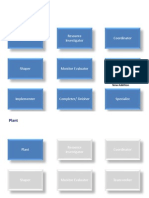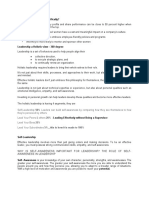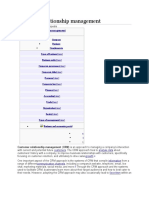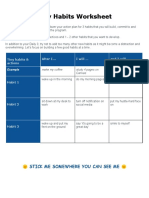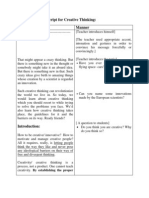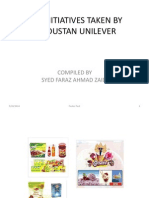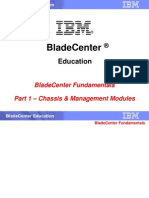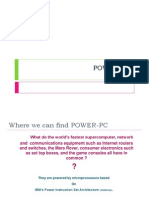Techniques of Creative Thinking
Techniques of Creative Thinking
Uploaded by
monirba48Copyright:
Available Formats
Techniques of Creative Thinking
Techniques of Creative Thinking
Uploaded by
monirba48Original Description:
Original Title
Copyright
Available Formats
Share this document
Did you find this document useful?
Is this content inappropriate?
Copyright:
Available Formats
Techniques of Creative Thinking
Techniques of Creative Thinking
Uploaded by
monirba48Copyright:
Available Formats
BY- ASHISH KUMAR MISHRA
FOCUS GROUPS BRAINSTORMING
ATTRIBUTE ANALYSIS
SYNECTICS
A focus group is a form of qualitative research in which a group of people are asked about their attitude towards a product, service, concept, advertisement, idea, or packaging. Questions are asked in an interactive group setting where participants are free to talk with other group members The first focus groups were created at the Bureau of Applied Social Research by associate director, sociologist Robert K. Merton. The term itself was coined by psychologist and marketing expert Ernest Dichter
Two-way focus group - one focus group watches
another focus group and discusses the observed interactions and conclusion
Dual moderator focus group - one moderator
ensures the session progresses smoothly, while another ensures that all the topics are covered
Dueling moderator focus group - two moderators
deliberately take opposite sides on the issue under discussion
Respondent moderator focus group - one or more
of the respondents are asked to act as the moderator temporarily Client participant focus groups - one or more client representatives participate in the discussion, either covertly or overtly Mini focus groups - groups are composed of four or five members rather than 6 to 12 Teleconference focus groups - telephone network is used Online focus groups - computers connected via the internet are used
Invite around 6 to 8 people to participate for a session
to last for about an hour. Then, prepare an agenda including a list of the top-level issues to be tackled (if appropriate). Prepare an introduction script explaining the purpose of the day and how the day will be run. This can include issues of consent and fire regulations (if relevant). Be sure to always use a quiet room with few distractions and arrange people in a circle (possibly around a table).
To facilitate useful, free-flowing discussion during the focus group, follow some of these tips: Ask participants to think about an issue for a few minutes
and write down their responses Ask each participant to read, and elaborate on, one of their responses Note the responses on a flipchart/whiteboard Once everyone has given a response, participants will be asked for a second or third response, until all of their answers have been noted These responses can then be discussed
Group discussion produces data and insights that
would be less accessible without interaction found in a group settinglistening to others verbalized experiences stimulates memories, ideas, and experiences in participants. Group members discover a common language to describe similar experiences. This enables the capture of a form of native language or vernacular speech to understand the situation
Focus groups also provide an opportunity for
disclosure among similar others in a setting where participants are validated
The researcher has less control over a group than a
one-on-one interview, and thus time can be lost on issues irrelevant to the topic
The number of members of a focus group is not large
enough to be a representative sample of a population; thus, the data obtained from the groups is not necessarily representative of the whole population, unlike the data of opinion polls.
Way of making of a group of people all think about something at same time, often in order to solve a problem or to create a good idea (oxford dictionary)
Brainstorming is a group creativity technique designed to generate a large number of ideas for the solution of a problem. In 1953 the method was popularized by Alex Faickney Osborn in a book called Applied Imagination.
Focus on quantity: This rule is a means of enhancing
divergent production, aiming to facilitate problem solving through the maxim, quantity breeds quality. Withhold criticism: In brainstorming, criticism of ideas generated should be put 'on hold'. By suspending judgment, participants will feel free to generate unusual ideas. Welcome unusual ideas: To get a good and long list of ideas, unusual ideas are welcomed. These new ways of thinking may provide better solutions. Combine and improve ideas: Good ideas may be combined to form a single better good idea, It is believed to stimulate the building of ideas by a process of association.
Set the problem
Create a background memo
Select participants Create a list of lead questions
Session conduct
Nominal group technique
Group passing technique Team idea mapping method
E- brainstorming
Directed brainstorming Individual brainstorming
Attribute analysis is the process of breaking down a problem, idea, or thing into attributes or component parts and then thinking about the attributes rather than the thing itself.
Synectics is a problem solving method that stimulates thought processes of which the subject may be unaware. This method was developed by George M. Prince and William J. J. Gordon, originating in the Arthur D. Little Invention Design Unit in the 1950s. Synectics is based on a simple concept for problem solving and creative thinking - you need to generate ideas, and you need to evaluate ideas. Whilst this may be stating the obvious the methods used to perform these two tasks are extremely powerful.
Creative thinking techniques are very much useful to generating new ideas in every organization . The new way of thinking should always be encouraged and creativity should always be welcomed.
You might also like
- V S M PDF F - L: Irtual Heet Usic Iles IcenseDocument6 pagesV S M PDF F - L: Irtual Heet Usic Iles IcenseKorey FrasNo ratings yet
- Edit - 6 Step Guide To Choosing Your Dream Career (Ebook Lead Magnet)Document17 pagesEdit - 6 Step Guide To Choosing Your Dream Career (Ebook Lead Magnet)jeetlalwala845No ratings yet
- Corporate Social Responsibility - Tata Consultancy Services (TCS)Document17 pagesCorporate Social Responsibility - Tata Consultancy Services (TCS)monirba48No ratings yet
- Solid State DevicesDocument42 pagesSolid State Devicesmonirba48No ratings yet
- Mba Mba Employment Statistics StatisticsDocument26 pagesMba Mba Employment Statistics StatisticsVaidyanathan NateshanNo ratings yet
- Making It As A Middle School Teacher: ©michelle LundyDocument6 pagesMaking It As A Middle School Teacher: ©michelle LundyKhurshid AnwarNo ratings yet
- Assignment-2 (Design Thinking)Document12 pagesAssignment-2 (Design Thinking)ANURAG SHUKLANo ratings yet
- What Is BrainstormingDocument3 pagesWhat Is BrainstormingMary MillareNo ratings yet
- Innovation and Creativity Lec TwoDocument14 pagesInnovation and Creativity Lec TwobenNo ratings yet
- DESIGN in Business Model (SPBM)Document5 pagesDESIGN in Business Model (SPBM)Mudassar Husain AnsariNo ratings yet
- What Is Ideation, and Where Does It Fit Into The Design Thinking Process?Document8 pagesWhat Is Ideation, and Where Does It Fit Into The Design Thinking Process?AnandVirat GattiNo ratings yet
- Lecture of Chapter Four Group BehaviourDocument35 pagesLecture of Chapter Four Group BehaviourAwet0% (1)
- Class 1: An Introduction To Human-Centered Design What Is Human-Centered Design?Document16 pagesClass 1: An Introduction To Human-Centered Design What Is Human-Centered Design?dreamer4077No ratings yet
- Aside From Product Innovation Where Else Can Ideation Be Applied in Your Life? List As Many As You CanDocument3 pagesAside From Product Innovation Where Else Can Ideation Be Applied in Your Life? List As Many As You CanCK GueraNo ratings yet
- How To Be CreativeDocument18 pagesHow To Be CreativeYUdeNo ratings yet
- Creative Ideas FormedDocument2 pagesCreative Ideas FormedEdlyn May Aquino AguilarNo ratings yet
- Citation of Innovative Techniques Used in The IndustryDocument10 pagesCitation of Innovative Techniques Used in The IndustryRahul RamachandranNo ratings yet
- Idea Generation TechniquesDocument5 pagesIdea Generation TechniquesmansoormbaNo ratings yet
- The Team Roles: Plant Resource Investigator CoordinatorDocument19 pagesThe Team Roles: Plant Resource Investigator CoordinatorParived BhatnagarNo ratings yet
- Story Line For Webinar - LeadershipDocument7 pagesStory Line For Webinar - LeadershipmagrinraphaelNo ratings yet
- Adaptability Skills 1578566425Document1 pageAdaptability Skills 1578566425Minh NguyenNo ratings yet
- Bite-Sized Training™: Get Creative!Document13 pagesBite-Sized Training™: Get Creative!sherifabNo ratings yet
- 16 Statements To Answer: Not at All Rarely Some Times Often Very OftenDocument5 pages16 Statements To Answer: Not at All Rarely Some Times Often Very OftenshalininelsonNo ratings yet
- Brian Tracy A Guide For Creative Thinking PDFDocument4 pagesBrian Tracy A Guide For Creative Thinking PDFdimogjNo ratings yet
- Workplace InnovationDocument52 pagesWorkplace InnovationAlpha June CedulloNo ratings yet
- Leaders Interpersonal Skills and Its EffectivenessDocument11 pagesLeaders Interpersonal Skills and Its EffectivenessHemant HuzooreeNo ratings yet
- Exercises For Innovation (Use Your Group Number According To Activity No.)Document2 pagesExercises For Innovation (Use Your Group Number According To Activity No.)Hope Grace GimaranganNo ratings yet
- Metacognition For The Classroom and BeyondDocument55 pagesMetacognition For The Classroom and BeyondLAILANIE DELA PENANo ratings yet
- Measurement With A Focus: Goal-Driven Software MeasurementDocument4 pagesMeasurement With A Focus: Goal-Driven Software MeasurementLydia LeeNo ratings yet
- Memory & Cognitive LearningDocument60 pagesMemory & Cognitive LearningSehrish AnsariNo ratings yet
- Workshop 2-Problem SolvingDocument8 pagesWorkshop 2-Problem Solvingcamila ramirezNo ratings yet
- Self Development PresentationDocument21 pagesSelf Development PresentationpradeepNo ratings yet
- Vision: The Broadest View: That Which You Strive ForDocument9 pagesVision: The Broadest View: That Which You Strive ForDavid Bozin0% (1)
- Creative Thinking PDFDocument56 pagesCreative Thinking PDFZulfazli Asmurad100% (3)
- Mind Mapping and Story OutlineDocument11 pagesMind Mapping and Story Outlineapi-280765340No ratings yet
- Critical Thinking and Decision Making AssessmentDocument2 pagesCritical Thinking and Decision Making AssessmentGreek GamingNo ratings yet
- Summary 2 TCH Story PitchDocument2 pagesSummary 2 TCH Story PitchVasanth RajaNo ratings yet
- Bootcampbootleg 2010Document48 pagesBootcampbootleg 2010Yi-Hsien SuNo ratings yet
- Style of LearningDocument20 pagesStyle of LearningSab 1001No ratings yet
- 5 Influencing Styles-And How To Use Them Effectively Advisor ServicesDocument1 page5 Influencing Styles-And How To Use Them Effectively Advisor ServiceskushwaharunNo ratings yet
- Unit 3 - Emotional IntelligenceDocument42 pagesUnit 3 - Emotional IntelligenceJide Williams50% (2)
- A.) Identificatio: Grow More Coach Model Rights Reserved C13Document1 pageA.) Identificatio: Grow More Coach Model Rights Reserved C13Supreet SinghNo ratings yet
- Customer Relationship ManagementDocument14 pagesCustomer Relationship ManagementSaikumar SelaNo ratings yet
- Session 10. Discovering Profound Insights Into Operational Excellence (Watson, 2020)Document56 pagesSession 10. Discovering Profound Insights Into Operational Excellence (Watson, 2020)taghavi1347No ratings yet
- Six Thinking Hats - . - by Edward de Bono Six Thinking Hats - . - by Edward de BonoDocument20 pagesSix Thinking Hats - . - by Edward de Bono Six Thinking Hats - . - by Edward de BonoShipra SinhaNo ratings yet
- Design Thinking 2324 5Document35 pagesDesign Thinking 2324 5Diogo MadalenoNo ratings yet
- Book Review The Disney Way Management EssayDocument16 pagesBook Review The Disney Way Management EssayPaul Arman MurilloNo ratings yet
- Right or Kind?: Navigating The Soft Skills RevolutionDocument20 pagesRight or Kind?: Navigating The Soft Skills RevolutionMescasaNo ratings yet
- Tiny Habits WorksheetDocument1 pageTiny Habits Worksheetstephen sowahNo ratings yet
- Creative Thinking TechniquesDocument24 pagesCreative Thinking TechniquesbijuajitheshNo ratings yet
- Mindset QuizDocument4 pagesMindset QuizMara NagyNo ratings yet
- Problem Solving StrategiesDocument8 pagesProblem Solving StrategiesThushara ANo ratings yet
- A Transformation of The Learning Function Why It Should Learn New WaysDocument6 pagesA Transformation of The Learning Function Why It Should Learn New WaysFamiglia RedNo ratings yet
- The Presentation Script For Creative Thinking (Updated)Document9 pagesThe Presentation Script For Creative Thinking (Updated)Jadhav Nilesh AshokNo ratings yet
- Growth Mindset Week 1: Grade/Subject: Health Unit: Growth Mindset Lesson Duration: 45 MinDocument8 pagesGrowth Mindset Week 1: Grade/Subject: Health Unit: Growth Mindset Lesson Duration: 45 Minapi-485518104100% (1)
- Responsive Web Design: Fort Collins Internet Professionals August 12, 2010Document51 pagesResponsive Web Design: Fort Collins Internet Professionals August 12, 2010Barbara LyschenkoNo ratings yet
- Customer Focus: Managing For Quality and Performance Excellence, 9E, © 2014 Cengage PublishingDocument44 pagesCustomer Focus: Managing For Quality and Performance Excellence, 9E, © 2014 Cengage PublishingVictoria MaraginNo ratings yet
- Bootcamp BootlegDocument47 pagesBootcamp BootlegJulieth Guzmán SánchezNo ratings yet
- Creativity, Innovation, and Leadership.Document37 pagesCreativity, Innovation, and Leadership.Sneha KumariNo ratings yet
- Cdio Creative Thinking RubricDocument2 pagesCdio Creative Thinking Rubricshamsukarim2009No ratings yet
- BeyondDesignThinking PlanDocument1 pageBeyondDesignThinking PlannunobNo ratings yet
- Ppts-Charms of Being An Entrepreneur 2010Document10 pagesPpts-Charms of Being An Entrepreneur 2010ananth2309100% (1)
- Innovation Best Practices 3mDocument4 pagesInnovation Best Practices 3mDarleen Joy UdtujanNo ratings yet
- AI, ML, and Knowledge Management Unite: Unleashing the PowerFrom EverandAI, ML, and Knowledge Management Unite: Unleashing the PowerNo ratings yet
- Assessment of Working Capital Requirements Form Ii: Operating StatementDocument6 pagesAssessment of Working Capital Requirements Form Ii: Operating Statementmonirba48No ratings yet
- Caiib Fmmodbacs Nov08Document91 pagesCaiib Fmmodbacs Nov08monirba48No ratings yet
- Saurabh Kumar - OngcDocument16 pagesSaurabh Kumar - Ongcmonirba48No ratings yet
- Nitish Shukla Fortis Health CareDocument16 pagesNitish Shukla Fortis Health Caremonirba48No ratings yet
- CAIIB Financial ManagementDocument40 pagesCAIIB Financial Managementmonirba48No ratings yet
- CSR Initiatives Taken by Hindustan Unilever: Compiled by Syed Faraz Ahmad ZaidiDocument40 pagesCSR Initiatives Taken by Hindustan Unilever: Compiled by Syed Faraz Ahmad Zaidimonirba48No ratings yet
- Prateek Mishra - Icici FoundationDocument9 pagesPrateek Mishra - Icici Foundationmonirba48No ratings yet
- Basis of ChargeDocument21 pagesBasis of Chargemonirba48No ratings yet
- Ashutosh Singh So Mr. S Singh - TcsDocument17 pagesAshutosh Singh So Mr. S Singh - Tcsmonirba48No ratings yet
- PRINT MEDIA - Yesterday, Today and TomorrowDocument21 pagesPRINT MEDIA - Yesterday, Today and Tomorrowmonirba48No ratings yet
- Technological Upgradation in Small Scale IndustriesDocument17 pagesTechnological Upgradation in Small Scale Industriesmonirba48100% (1)
- Scope Challenges International Marketing PDFDocument0 pagesScope Challenges International Marketing PDFmonirba48No ratings yet
- Human Resource Accounting Concepts & MethodsDocument16 pagesHuman Resource Accounting Concepts & Methodsmonirba48No ratings yet
- Presented By:-Ambuj Kumar Tiwari Mba 3 SemesterDocument8 pagesPresented By:-Ambuj Kumar Tiwari Mba 3 Semestermonirba48No ratings yet
- By-Rohit Joshi Mba 3 Sem MonirbaDocument17 pagesBy-Rohit Joshi Mba 3 Sem Monirbamonirba48No ratings yet
- History of Indian AdvertisingDocument22 pagesHistory of Indian Advertisingmonirba48No ratings yet
- A Factors of Pathfinding For Improving 3D Game PerformanceDocument3 pagesA Factors of Pathfinding For Improving 3D Game PerformanceInternational Journal of Application or Innovation in Engineering & ManagementNo ratings yet
- Formula KpiDocument24 pagesFormula KpiSajjad SafdarNo ratings yet
- Supplemental Ds 1Document2 pagesSupplemental Ds 1viksursNo ratings yet
- LIC Set - 1Document11 pagesLIC Set - 1smartkeedaNo ratings yet
- xw5033 3.50 Part 1 ChassisDocument153 pagesxw5033 3.50 Part 1 ChassisJavier TofaloNo ratings yet
- Tube Laser IntroductionDocument12 pagesTube Laser IntroductionPanagiotisNo ratings yet
- Ib Biology Internal Assessment Checklist-1Document3 pagesIb Biology Internal Assessment Checklist-1John LunaNo ratings yet
- Development of Small Hydroelectric Projects by UjvnlDocument9 pagesDevelopment of Small Hydroelectric Projects by UjvnlRam21abiNo ratings yet
- Power PCDocument50 pagesPower PCramu497No ratings yet
- Mfiv-II Mechanically Controlled Isolation Valve PsDocument2 pagesMfiv-II Mechanically Controlled Isolation Valve PsalainestorNo ratings yet
- What Are The Facilitating Factors To The Adoption of BIM in The UK Quantity Surveying Profession?Document53 pagesWhat Are The Facilitating Factors To The Adoption of BIM in The UK Quantity Surveying Profession?David BanksNo ratings yet
- Web2Project User Guide V1Document26 pagesWeb2Project User Guide V1Freddy VergaraNo ratings yet
- Task 3 Solution (Pseudocode) : Sir Mym (0332-3033505) Sir Bandeshah (0333-2076121)Document3 pagesTask 3 Solution (Pseudocode) : Sir Mym (0332-3033505) Sir Bandeshah (0333-2076121)saraNo ratings yet
- Licom AlphaCamDocument27 pagesLicom AlphaCamMario SabatinoNo ratings yet
- 12 Solutions For Fixing Common TEVDocument7 pages12 Solutions For Fixing Common TEVRahul ChandrawarNo ratings yet
- FSK Ang PDFDocument10 pagesFSK Ang PDFAchraf FanidNo ratings yet
- Torno Grizzly g1495 - PLDocument8 pagesTorno Grizzly g1495 - PLrobles doloresNo ratings yet
- Teaching Resume Reynolds, KarleenDocument2 pagesTeaching Resume Reynolds, Karleenapi-285009699No ratings yet
- PG 2Document1 pagePG 2Bailey DunningNo ratings yet
- Design Brief - Great RoomDocument3 pagesDesign Brief - Great RoomSaranya MurugesanNo ratings yet
- Final LCSMDocument9 pagesFinal LCSMDavid BabaganovNo ratings yet
- 1) What Are The Four Functions Included Within The Scope of Manufacturing Support Systems?Document4 pages1) What Are The Four Functions Included Within The Scope of Manufacturing Support Systems?Muhamad RadhziNo ratings yet
- Senz 3Document63 pagesSenz 3Didi MoacaNo ratings yet
- Ce2025 Architecture Book by Pixor Publications - 1452476012495Document13 pagesCe2025 Architecture Book by Pixor Publications - 1452476012495R CUTSNo ratings yet
- Assessment Task 3Document4 pagesAssessment Task 3besk0200% (1)
- Power Pulse Valves PDFDocument12 pagesPower Pulse Valves PDFUrip S. SetyadjiNo ratings yet
- BooksDocument1 pageBooksAmit kumarNo ratings yet


















